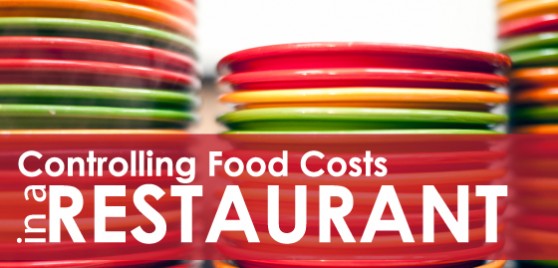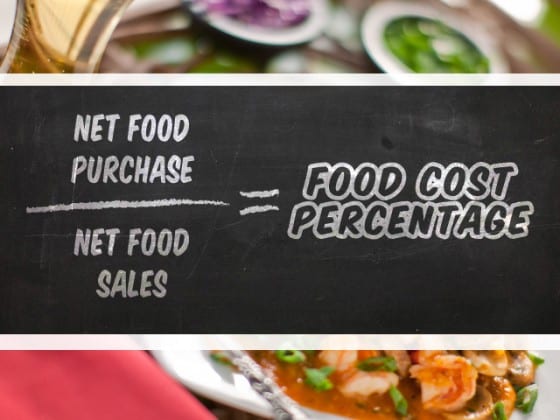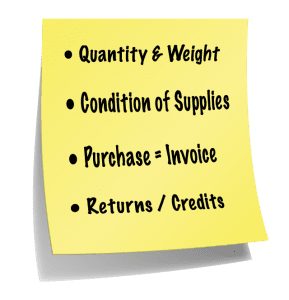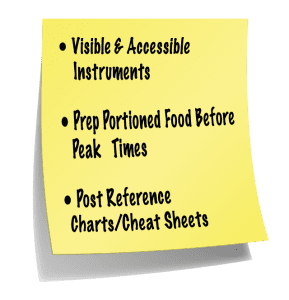
Anyone who has ever run a quick-service or full-service restaurant knows just how big of a factor food costs are to their ultimate success. While the industry, especially quick-service restaurants, presents unique challenges for staffing, most owners would say that controlling food costs is one of the most important keys to running a profitable restaurant. This is due to slim margins (research by the National Restaurant Association has the average profit per dollar in food service at about .05!) and the sheer percentage of costs represented by food.
While food and beverage costs can vary depending on the type of restaurant, it is not uncommon to see this represent 25-40% of the restaurant’s total cost. Outside of labor, which can be in a similar range of 25-35%, there is no other cost so big when it comes to a restaurant’s cost structure. This is why food and labor costs are called “prime costs” within the industry. They are the biggest costs for any given restaurant and the ones over which the restaurants have the most control. Generally restaurants aim to have prime costs in the 60-65% range.
With this in mind we’ve put together a guide with resources on how to control food costs in your restaurant. Control your costs, create an excellent ambiance, hire well, and you are well on your way to running a successful restaurant!
Food Cost Formula & Definition
Before we dive into some common food cost control principles and methods let’s briefly define what food cost is. Food cost is simply the total cost of your food net of existing inventory. Usually beverage costs are counted separately but occasionally these are combined. When expressed in a percentage, the food cost is simply one’s net food purchases divided by the restaurant’s net sales. Multiply by one hundred and you have your food cost percentage.
Food Cost Percentage = Net Food Purchases / Net Food Sales

A numerical example can be found here. This simple calculation gives restaurant owners an excellent benchmark as to what their costs should roughly be. While the industry rule of thumb is 30%, if not known, owners should do some research for their specific type of restaurant or industry to know what the specific average is.
Basics of Restaurant Food Cost Control
Regardless of the type of restaurant, there are a number of basic principles that should form the foundation of any restaurant owner’s efforts to control food costs. In no particular order here are ten principles to follow.
Have a Variety of Vendors / Suppliers
Simply put, having all your eggs in one basket is not smart. If you are sourcing a large percentage, or even all of your food supplies from one or two vendors then it’s time to look for additional suppliers. While getting supplies through one or two vendors may result in quantity discounts and favorable pricing built through years of a professional relationship, oftentimes it is even cheaper to have more than one vendor. This is because having one vendor can mean you are subject to any fluctuations or changes in their cost structure. For example, if they have a bad year and need to increases prices to offset a poor crop they are going to undoubtedly pass this cost onto you. Having more than one vendor, or at the very least knowledge of more than one, gives you the flexibility to quickly shop around for the best price.
This set up allows you to monitor external variables and be a proactive buyer instead of a reactive one. What this means is that weather patterns, seasonal ups and downs, supply chain anomalies and more can ultimately affect the cost of your food and supplies. While it’s nearly impossible to accurately predict these types of variables correctly all of the time, years of experience and careful analysis can allow savvy buyers to anticipate future supply and demand. Armed with this knowledge and multiple suppliers/vendors restaurants can be proactive in making purchases before prices are prohibitive or supply is limited.
This doesn’t mean that you should view all your relationships with vendors from a “me-only” perspective. In fact, doing so will hurt you more than help you. Work hard to develop relationships with your vendors but make sure to be open and honest with them that you have to balance quality and cost. They are a business too and will understand this. This open communication will ensure that nothing is taken as personal if other vendors are chosen from time to time.
Here are a couple great places to look for food suppliers:
Food Supplier – find food suppliers and other restaurant supplies and equipment.
FoodsTrade – find food suppliers and other industry related businesses.
Receiving Controls
No matter how well you do anything else mentioned in this guide if you are inaccurately receiving what you’ve purchased you will not be able to control food costs. It is critical that whoever receives your purchases checks both weights and quantity depending on how the item is priced to ensure everything is present. Also, ensure that not just the proper amount is present but that the food supplies are in good condition and not already spoiled. The last things to check are that the purchase and invoice amounts are correct and that any damaged or returned goods are properly credited to your account. With a little effort at the beginning of the process, food costs can be much better controlled when the final calculation is done.
Menu Selection
While your menu will in large part be dictated by the type of your restaurant or your location, a carefully planned menu will go a long way in reducing food costs. This is because the smartest restaurant owners will mix and match menu options that balance the need for popular and profitable food. Much like grocery stores who use loss leaders and store layouts to drive impulse purchases, menus can be construed in a way that if certain menu items make very little money they are offset by the added value of having more people in the store buying additional items. In other words, not all of your menu items need to be have the highest profit margin that you can possibly achieve. Construct your menu in a way that brings people into your store for your delicious food and great deals and you’ll reap the rewards of higher per-ticket visits.
One of the keys when costing out your menu is to involve those people who handle the food most often. They can give you the most realistic estimates of how much food is required in any given appetizer or dish. With the this accurate information owners can then price accordingly. Having priced out your menu don’t forget to make adjustments as needed as food supplies and costs change over time. No restaurant should drastically change their prices frequently but occasional price changes due to changing costs, if done well, will not alienate your customer base nor leave you losing money on your menu items.
Buffet & Salad Bar Cost Control
Hand-in-hand with menu selection is a buffet or salad bar offering. These are typically big draws for restuarants’ customers and can be perfect for filling seats that lead to more purchases. Nonetheless, food cost control for these types of offerings is often poorly done or completely ignored.
The Restaurant Experts give a great breakdown of how to cost out buffets and salad bars. Here’s a quick summary of how restaurant owners can accurately cost out these types of food offerings.
Use an average day in terms of sales and customers and do the following:
1. Record all costs to set up and replenish the buffet or salad bar.
2. At the end of the day subtract the cost of food that is still in good enough condition to be used later.
3. With your net cost in hand, divide this number by the number of customers who ate at the salad bar or buffet. This will give you a cost per customer.
4. Compare your cost per customer to what you are charging for the salad bar or buffet.
5. Adjust pricing or cost control measures as needed.
Here are a couple of great resources on costing menus and menu engineering.
How To Price a Menu – Food Service Warehouse
Menu Engineering – Menu Cover Depot
Training and Portion Size
Another way to ensure you are controlling food costs is to ensure that those working in the kitchen are adhering to the portion sizes outlined in your documentation. If you haven’t done this already it is a must – just make sure to use an accurate scale or measuring units when doing so!
All restaurants should have portion sizes figured out as a way to control food costs and most do. The weak spot in the chain of planning and execution is often kitchen employees either using too little or too much food than what is called for. Too little and your restaurant will develop a reputation for small portion sizes which can easily lead to negative online reviews and a digital kiss of death. This is applicable to both pre-set food as well as food used in dishes which are prepared as they are ordered. Too much food and your food costs will soar out of control. The key is to set portion sizes, properly train kitchen staff on adhering to these sizes and constantly measure and evaluate performance and adjust portion sizes as needed. Rinse and repeat.
One of the most effective solutions to reduce waste in regards to inaccurate portion sizes being served or prepared is to ensure that appropriate measuring cups, spoons, scales, bowls, etc are visible and accessible. This will help food preparation staff not to simply eyeball or estimate amounts and reduce variance in food costs for pre-measured proportions. Doing some of this work before busy times is extremely effective as well. At the very least a reference chart or cheat sheet of proper portions and measurements will ensure kitchen staff can meet demand while still staying within portion sizes.
Beyond just adhering to portion sizes one way to evaluate if the actual portion sizes are correct is to evaluate plates returning to the kitchen. Are there certain trends or patterns for certain dishes which consistently come back with an excess of food? Or are there certain dishes that are always being boxed for customers to take home? If this is the case, it is a great indicator that portion sizes for those dishes can be reduced. This will quickly leads to savings that can be used in other areas where portion sizes may be too small.
The training aspect also applies to the wait staff and not just those working in the kitchen. Knowing that some food items and supplies have a shorter shelf life means there needs to be communication and encouragement from whoever knows the inventory best with those selling the actual item. This will help ensure that overlooked or less purchased items that may otherwise go to waste are sold more often.
Measure, Measure, Measure
While most chefs and backroom employees are much more concerned about making the perfect meal at the end of the day each meal needs to minimize waste. This means that food waste needs to be constantly tracked to ensure that meals and the menu as a whole is staying within previously allocated cost structures. Measuring and evaluating usage of food supplies will also provide insights into what a restaurant can and can’t offer depending on what the percentage goal and actual usage levels are at.
This tracking can be done with paper and pen or digitally. Regardless of how it is recorded having the kitchen staff do this usually is the best solution since they are the ones that handle the food. Doing so on a daily basis will ensure that management can make adjustments and improve food costs over time. These kinds of waste sheets also will point management to processes that may need improvement. Finally, tracking carefully will allow owners and managers to find the proper balance between offering their most popular and profitable dishes.
Here are a couple of waste logs/sheets for restaurants:
Food Waste Log – a simple but functional food waste log.
Waste Log Book – this one is from the EPA, is more official and includes instructions and tips as well.
Regular Inventory
Regularly and properly counting food inventory will help reduce waste tremendously. It allows the purchaser to more effectively order as described below. Doing a regular inventory will also make sure a First In, First Out (FIFO) inventory management method is used. Avoid wasting food simply because it’s unorganized in storage and newer items are used first!
Here is a good resource on how to conduct proper inventory counts:
Order Proper Quantities
Another bedrock principle is ordering the correct amounts. The key to ordering well is knowing how much your restaurant uses on any given day or seasonal period. This is another reason measuring waste and sticking to portion sizes becomes so important. Correct and consistent food supply usage measurement will provide more data to make better ordering choices. Ordering correctly means restaurants not only avoid wasted product but having to pay premium pricing for stop-gap inventory needs.
Eliminate Human Error
While this one sounds obvious it is difficult to accomplish. Waste usually comes in two ways – spoilage and human error or apathy. Preventing spoilage often is offset by proper ordering as discussed above. This is particularly the case with extremely perishable foods. Those in charge of ordering shouldn’t be averse to ordering on a regular (even daily) basis to ensure that perishable foods (think produce, fruit, vegetables, etc) don’t spoil before being used.
The human error or apathy component is largely a training issue. Managers and owners need to instruct and emphasize that kitchen staff use food supplies as judiciously as possible. Other methods that help reduce this kind of waste are menu items designed to use scraps or seldom used parts of food. While owners and managers can’t force customers to choose these dishes they can be priced lower to encourage purchases. Likewise, management can offset errant wasting by properly staffing to ensure that food isn’t lost during the preparation phase due to an extremely busy period in which food is overcooked, incorrectly prepared, dropped, etc. The combination of proper training and sufficient staff can go a long way in reducing waste of food supplies.
Incentivize Employees
While this isn’t a core principle of eliminating waste it is a viable tactic to help implement some of these principles and practices. Incentives can range from monetary bonuses or punishments to other perks for kitchen and/or wait staff who control food waste or promote/sell low cost menu items. As with all compensation plans it needs to be fair and realistic. When done correctly, it can help out tremendously.
Sales Recording
It’s important to note that just as critical as proper food cost control are accurate and comprehensive policies in place to record sales. Missed or under-recorded sales figures will inflate your food cost percentages and may drive cost control policies that aren’t needed or are already working well. The easiest way to do this is the “no ticket, no food” approach. This just means that no food is prepared or served unless there is a ticket produced for that food from someone on the wait staff. This ensures that the ticket goes through some kind of point of sale system before being prepared and guarantees food isn’t being prepared for nobody. This one simple policy oftentimes reduces costs by up to five percent.
While there are assuredly other principles and practices to food cost control, implementing those listed above should put any restaurant well on their way to controlling half of their prime costs. It is important to remember that food cost control is an iterative process that should be continually refined to ensure there is a balance struck between cost control and making happy customers.



































